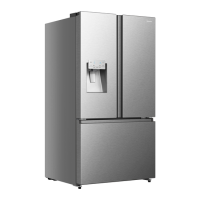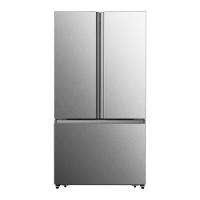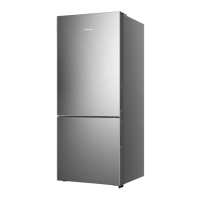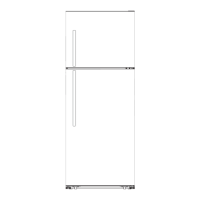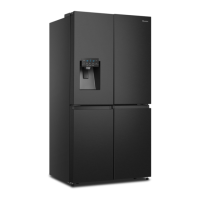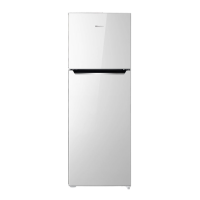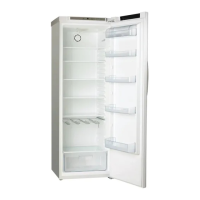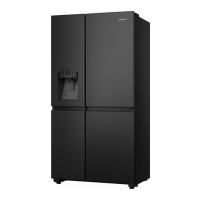Why does my Hisense HRF254N6TSE Refrigerator have odors from the compartments?
- AAdam CoxSep 12, 2025
Odors in your Hisense Refrigerator compartments may be due to the interior needing cleaning or from certain foods, containers, or wrapping.
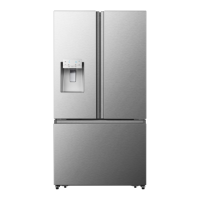
Why does my Hisense HRF254N6TSE Refrigerator have odors from the compartments?
Odors in your Hisense Refrigerator compartments may be due to the interior needing cleaning or from certain foods, containers, or wrapping.
| Brand | Hisense |
|---|---|
| Model | HRF254N6TSE |
| Category | Refrigerator |
| Language | English |
Guidelines for safe daily operation and food storage, including repair and air circulation.
Precautions for child safety, preventing suffocation and burns from hot components.
Instructions for safe electrical connections, grounding, and handling damaged power cords.
Ensures the refrigerator is placed on a level, strong surface away from heat and moisture.
Maintaining clear space around the appliance for efficient cooling and energy saving.
Recommended ambient temperature ranges for optimal appliance performance.
Details on water filter, pressure requirements, and potential need for a purifying system.
Warning about qualified plumbers, water pressure range, and potential leaks.
List of necessary tools and consumable parts for water line installation.
Labels for components like Automatic Ice Maker, Door Bin, Mullion, Crisper Drawer, Pantry, Shelves, and Air Channel.
Labels for components like Freezer Upper Drawer, Lower Drawer, Water Filter, and Crisper Cover.
Explanation of the control panel layout, icons, and automatic turn-off after inactivity.
How to activate/deactivate child lock and silence the door open alarm.
Instructions on how to turn the ice maker on and off using the 'Ice Off' button.
Instructions on how to dispense cold water using the dispenser lever.
Steps for obtaining cubed ice and crushed ice from the dispenser.
Detailed steps for shutting off water, removing, and installing a new water filter.
Guidelines for water pressure and filter compatibility with reverse osmosis systems.
How to remove, relocate, and use door bins for storage.
Steps for tilting and lifting glass shelves for removal and reinstallation.
How to fold and unfold the adjustable shelf for flexible storage.
Proper method for removing and using the crisper drawers for produce.
Initial setup, ice production time, and handling clumped ice.
Instructions for safely removing, emptying, and reinserting the ice bucket.
Warnings against excessive force, forceful door closure, and inserting hands into the ice chute.
How to clean the inside of the refrigerator and freezer compartments with baking soda solution.
Tips for cleaning the exterior surfaces, doors, and handles to maintain appearance.
Steps to manually defrost the freezer if excessive frost accumulates.
How to clean door seals to prevent sticking and tearing.
Procedure for safely replacing a damaged LED light by a competent person.
Tips to reduce energy consumption, such as limiting door openings and proper placement.
Guidance on refrigerating fresh food, including wrapping and placement.
Advice on storing meat, cooked food, fruits, vegetables, butter, cheese, and milk.
Tips for effective freezing, including portioning, wrapping, and preventing temperature rise.
Ensuring proper storage of frozen food and advice against refreezing defrosted items.
Steps to take when switching off the appliance for an extended period to prevent mold.
Checks for power, fuse, and ambient temperature issues when the appliance is not working.
Identifying causes of odors and normal/unusual noises from the appliance.
Reasons why the motor may run continuously and circumstances requiring more operation.
Troubleshooting frost buildup, too warm, or too cold temperatures inside the appliance.
Diagnosing issues with doors not closing easily and the LED light not working.
Common reasons for ice maker failure, including water supply, temperature, and setup issues.
Troubleshooting steps for a non-functional water dispenser, checking water lines and filter.
Instructions for recycling packaging materials.
Safety warnings and correct methods for disposing of the refrigerator and its components.
